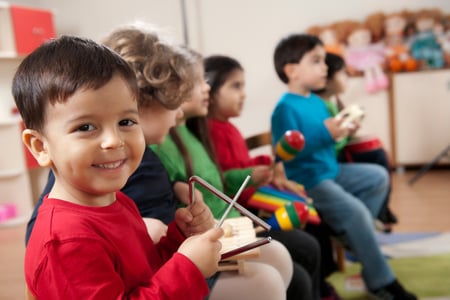
We’re continuing our celebration of NAEYC’s Week of the Young Child with Music Monday.
Children are born musicians. Babies turn their heads when they hear a parent or caregiver sing, toddlers sway to the music, and preschoolers dance and twirl around the kitchen (generally when one of their parents is trying to prepare a meal). Elementary-aged children may sit with a tablet to listen to music on their headphones, while older kids may walk around with earbuds permanently inserted in their ears. And what child has not picked up a stick or a kitchen utensil and used it to tap out a beat?
As it turns out, this interest in music is good for kids. Calm music can help reduce anxiety and stress while aiding in self-regulation. Children who sing rhyming songs learn about sounds, and children who try to figure out how to tap (or hit) the drum to make the loudest sound are using complex thinking skills.
A Helpful Rhythm
We know that young children thrive on predictability. That’s why they ask us to read the same book or sing the same song over and over again - long after we’ve gotten tired of the book or the song. Barney the purple dinosaur was popular when my children were small and even now, I cringe a bit when I hear the all-too-familiar refrain of “I love you, you love me.” If you’re feeling the same way about Baby Shark “...doo doo doo doo doo doo,” here are some ideas on how to promote music with your children.
1. Setting the “Tone” for the Day
Music is often used in the classroom to signal the start and stop of different activities - this helps children learn about and anticipate routines and expectations. The same can be true at home.Playing a song at key transitions in the day - starting with a song when it’s time to wake up - can help set that schedule. Younger children might enjoy hearing some of the same songs that they hear at school (greeting, hand washing, cleaning up, toothbrushing). If you don’t know the songs, ask the school if they can send them to you or share a playlist on Youtube or Spotify.
Here are some musically based activities that you can do with your children:
2. Don’t Have Instruments Around? Make Your Own!
You don’t need any special supplies to make your own instruments: an oatmeal box makes a great drum, a plastic container filled with dried beans can stand in for a maraca, and a paper towel tube can serve as a wind instrument. Your kids will have fun and may even give you an impromptu concert!
3. Experiment with Objects and Sounds
Take out your pots and pans (or plastic ware if you want to dull the noise) and let your kids experiment with different ways to make music. Ask questions like, “What kind of noise will this paintbrush make on this pan lid?” “ Do you think the sound will be louder or softer than the sound when we bang these two metal pan lids together?” “Why do you think that?” Older children may even be able to predict which household materials can best imitate the sounds and timbres of real-world instruments.
4. Follow My Lead
Support your child’s ability to recognize patterns by making up simple musical patterns and having your child repeat them. Once they get the hang of it, let them take a turn driving the rhythm.
5. Move and Groove
Internet resources mean that you and your child have access to music from decades past and countries far and wide. Explore new music together and share new vocabularies such as tempo, beat, rhythm, or genre. Make up dances to match the music!
6. Find The Right Sound
Do a musical scavenger hunt! Ask the child to find everything that can play music (phones, radios, tablets, computers, instruments, musical books).
The most important thing you can do to foster your child’s interest in music is to love it yourself. Music can not only be a great way to engage with your children, it can be therapeutic in these tough times. We hope this gives you some new ideas of ways to bring music into your children’s daily lives.
Other Music Resources
New York Philharmonic
PBS Kids
Sesame Street
Spotify
